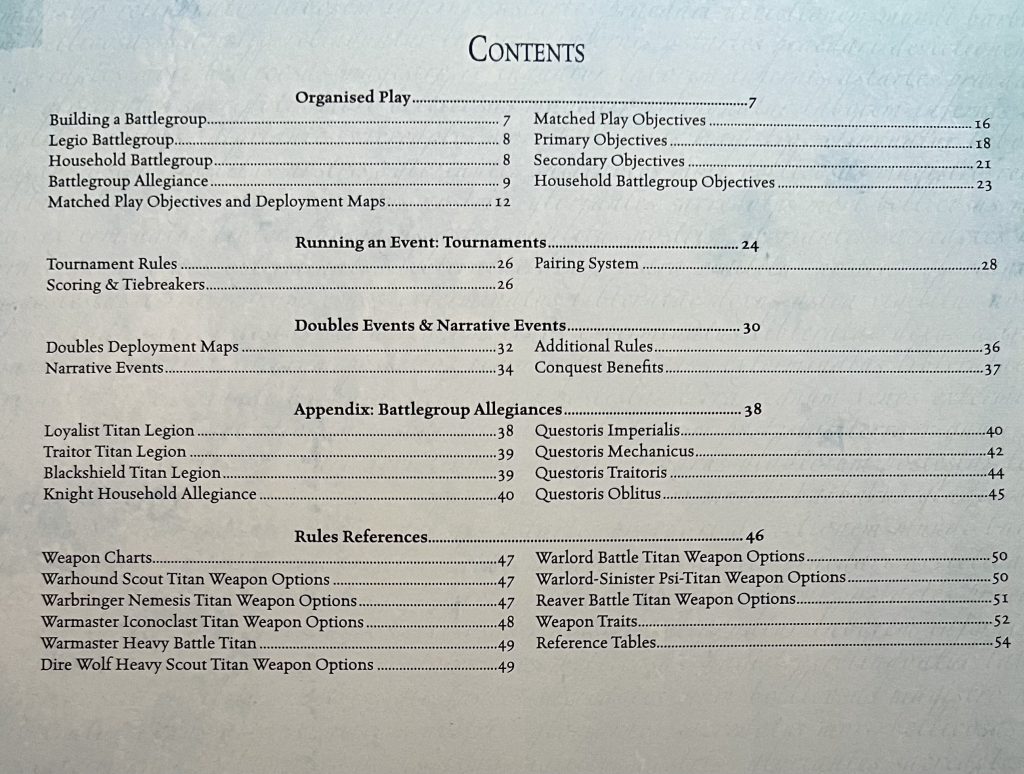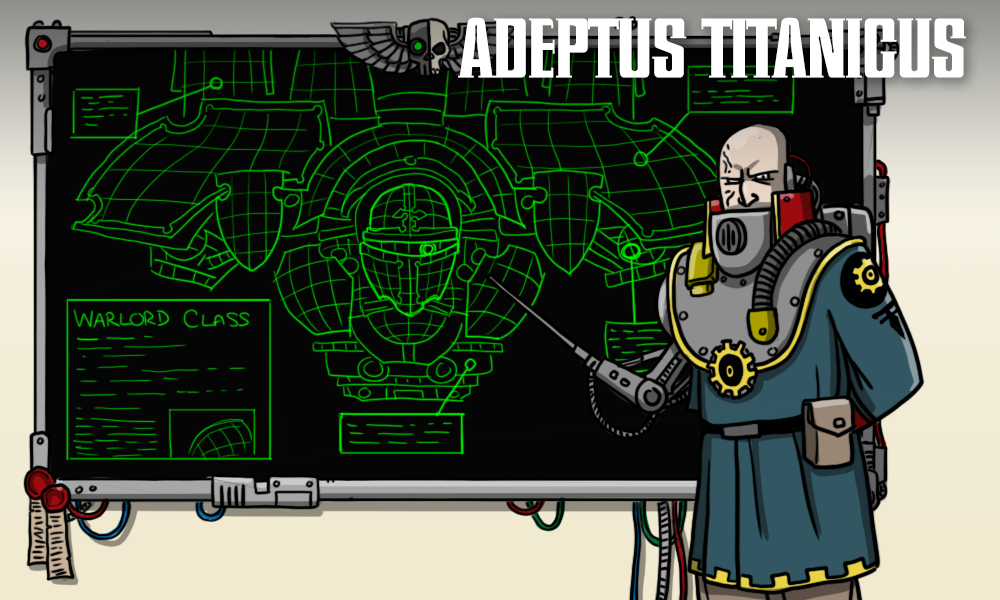Welcome back to Goonhammer’s series for aspiring Titan Principes. We here at Goonhammer’s own Collegia Titanica know that Adeptus Titanicus can seem intimidating to players unfamiliar with its particular quirks, but this series aims to equip you with everything you’ll need to play out epic clashes on the battlefields of the far future with your very own Titan Battlegroup. In this series, we’ll be walking you through how to build your battlegroup and command it to glory, including everything from which Titans to include and how to equip them, through to how to command them on the field of battle to secure ultimate victory.

Today we’re looking at the Titanicus Matched Play Guide and if it’s worth picking up. The book itself comes as a smaller paperback, packed with rules and reference tables – replacing the mission section of the default AT18 rulebook when you go to events… unless they’ve come up with their own rules of course.

Organised Play
The most interesting thing here is the introduction of Organised Play – effectively Matched Play 2.0. Aside from the Open War Cards (which immediately went out of stock), the matched play rules in the AT18 rule book have been the de-facto way to play the game. Let’s explore what changes the book has made to the format to keep things fresh.
Some notable items changes include:
- Stratagem Hand (expanded more below)
- The deployment map is now chosen by whoever controls the battlefield – very powerful given the terrain is already setup
- 10 Primary Missions and 6 Secondaries for both Titan Battlegroups and Knight Households
- Games are fixed at 5 turns
- No duplication of Princeps Traits
- Titans within a maniple must belong to a Legio
- The amount of stratagem points you get to use is basically unchanged, just with Epic Clash being better defined as over 1750 points for 4 stratagem points.
The Stratagem Hand
The Stratagem Hand is a neat revision to how Stratagems work in Adeptus Titanicus. During Battlegroup creation, you create your Stratagem Hand by selecting a number of stratagems based on the size of game you are playing. These get recorded on your roster and can be shared with your opponent for transparency at the start of the game.
During the course a game you may use Stratagems from the Stratagem Hand up to the usual SP allowance for your battle size. The Stratagem Hand then allows you to have a sideboard and include some more edge case stratagems you would never have taken otherwise previously. The added benefit of selecting the sideboard in advance of the game means there is no analysis paralysis of selecting stratagems at the start of the game – speeding things up.
For instance a Loyalist Titan Battlegroup playing a 1500 point game could choose:
- Concealment Barrage
- Iron Resolve
- Iron Resolve
- Last Ditch Effort
- Great Crusade Titans
- Vox Blackout.
Across the course of the game the player could then spend their stratagem points on that chosen hand – you still can’t go over the stratagem point limit for the game, though, so be careful with the combination of stratagems that you pick! You could come into a situation where you’ve used 4 out of your 5 allotted points for a game without any 1 point stratagems left to use.
Missions
The missions work in a similar fashion to the original Matched Play rules, although more missions are available – rolling two dice for each of your primary and secondary missions and selecting one.
What is nice is that none of the primary objectives are built around killing anything. Eight of the ten make use of objective markers (detailed as 32mm base sized) while the other two are about either keeping enemies away from your side of the board or pushing towards the enemy’s.
Many of these however will look similar to you if you’ve been playing Open Engine War missions, which isn’t a bad thing since these are often considered to be the best way to play the game. Others, like retrieval, are updates of missions from the rulebook.
Bair: Lysanda players will be happy that the majority of the time they can pick a mission and actually use their legio-specific stratagem to boost their damage output for a turn.
The default is now that players will be trying to do entirely different missions, but with the same cap of VPs – 25 for the Primary and 15 for the Secondary. This is a big improvement over the Rulebook missions, where you could often find that one player had more points available than the other.
Tertiary missions can’t take you over that 40 point maximum – instead they come from the 15 you can score for secondaries. This might seem like a nerf to Tertiaries but when you combine this change with the new stratagem hand things get a bit more interesting. You could put a Tertiary or two in your deck to give yourself some optional ways to score VPs. That’s some insurance against rolling difficult secondaries and will win you a game now and then.
NotThatHenryC: I think these are the best missions we’ve seen. The Open War deck was a big improvement over the Rulebook but I found some secondaries almost automatic and others very difficult. I don’t think all these missions are equally easy to achieve but they look pretty good to me.
Running Events
This section goes on to help new event-organisers with tips and advice on how to run their events; what to include, guidelines such as having a referee and spare player on standby, pairing systems, etc. Most of these things will be familiar to someone who frequents often, but could be useful to a group wanting to bootstrap this in their community.
It does explore an Objective Pool mechanic, which mitigates the random effect of rolling missions and the different ways of implementing it. This includes things like having a reduced list of primary/secondary objectives that players select from each round and can’t repeat.
Doubles Events
We’re glad to see the official implementation rules for the doubles format. This provides a common framework events can use on how doubles battlegroups, stratagems and objectives operate. This also includes some interesting Doubles deployment maps, which we look forward to using at our own events.
NotThatHenryC: This looks awesome and I can’t wait to give it a go! I just have to find someone who can tolerate teaming up with me…
Narrative Events
Despite what the books name suggestions, there is a Narrative section which discusses the various archetypes of campaigns such as Branching Tree or Conquest (map campaigns).
This section includes a bunch of tables of Battlefield effects and Conquest benefits which are a great inspiration for you to create your own narrative. These are the sort of effects that can take games of Titanicus the next level to really feel like you’re fighting somewhere instead of just random ruined Hive City #32432 for the hundredth time.
Reference
The book finishes off by including the rules for Allegiances, Reference Tables and Weapons. Much of this is reprinted from other books such as the Loyalist or Traitor books, but handy to have all in one place – eg. Traitors will be able to see what a Psi Titan does without having to borrow a mates Loyalist book.
Sadly, the latest weapons (like the new Graviton ones) are absent.
Is it worth it?
As anyone who has been playing Titanicus for four years will tell you, the original matched play missions do get a bit stale after time. The revision of how Stratagems and introduction of new missions is a welcome one. It’s a shame that a table of the Open War cards wasn’t included as well for those that couldn’t get their hands on them.
Soggy: While I would have preferred an AT 1.5 to overhaul some of the weapons (I’m looking at you Plasma Blastgun), this is a welcome mini-supplement that hopefully will stay in stock so it could become the new defacto way to have pickup games.
Bair: Realistically if you’re not able to get your hands on Open Engine War cards then it’s got some solid missions to play and the world effects are fun to add into games. Events that have been going so far will usually have their own packs and ideas as to how they want to run things, but for brand new event organisers it could be useful in how to set one up.


